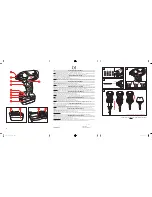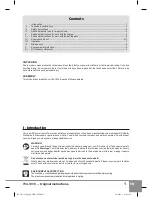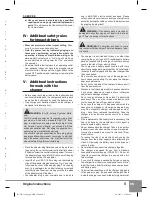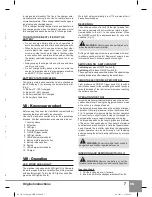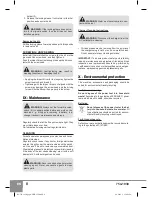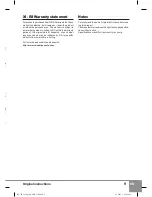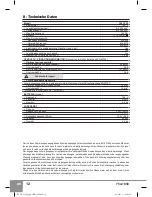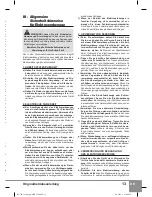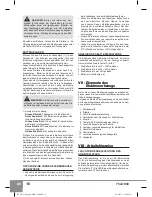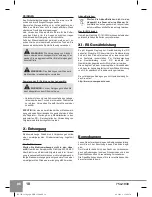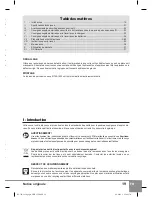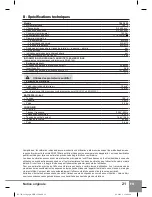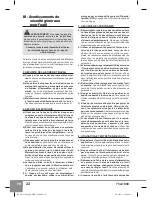
Original instructions
7
EN
WaRning:
Never attempt to open the battery
pack for any reason. If the plastic housing of the bat-
tery pack breaks or cracks, return to a service centre
for recycling.
ReaD all Of tHe instRUctiOns in tHe cHaR-
geR sectiOn Of tHis manUal befORe at-
tempting tO cHaRge tHe batteRy pack fOR
yOUR tOOl.
▪
Always use correct RS battery pack (the one supplied
with tool or a replacement pack exactly like it.) Never
install any other battery pack. It will ruin your tool and
may create a hazardous condition.
▪
Charge battery packs only in RS chargers.
▪
Use an environmentally safe disposal unit at a munici-
pal waste disposal centre to dispose of a damaged or
worn out battery.
fitting anD RemOving tHe batteRy
pack
To remove the battery from the machine: press the bat-
tery release button (9) and take the battery out of the tool.
WaRning:
Always set the forward/reverse
switch (4) in central position before any work on the
machine e. g. fitting and removing a battery, tool
change, transport, maintenance and storage.
To install the battery: Insert the charged battery (10) into
the slot below the button (9) until the battery is securely
latched with a click.
batteRy cHaRging
Insert the plug of the charger (12) in the socket, and the
charging indicator (11) will be flickered in green,red and
yellow in turn within one second. And then, the battery
charger will be in the standby position.
Insert the battery (10) in the battery charger considering
the polarity.
A new battery will work properly after five times of charg
-
ing and discharging. Charge and discharge a battery,
which is not used for a long time, for two to three times
to function well.
When the battery working time is remarkably short de-
spite full charging, the life of the battery may be over.
Replace the battery immediately.
WaRning:
The battery will be fully charged
after 1 hour, remove it from the charger after this time.
1) Charging indication:
green blinks:
Before charging
Red lights:
While charging
green lights:
Charging completed
Red blinks:
Overheat standby (Battery overheated)
yellow blinks:
charging impossible
2) If charging of the heated battery is attempted immedi-
ately after it has been used or charged, indicator blinks
in red (overheat standby). The fan in the charger auto-
matically starts running to cool the hot battery down to
normal temperature. After cooling, indication changes to
red glowing and charging begins.
3) This charger detects charge status and transfers to
fine charging mode when the battery has been almost
fully charged and keeps the battery in full charge state.
tO Obtain tHe best life fOR tHe
batteRy
▪
Do not recharge battery after a short operation to
avoid decreasing operation time and battery capacity.
▪
When battery is not in use, keep it away from other
metal objects like paper clips, coins, keys, nails,
screws, or other small metal objects that can make
a connection from one terminal to another. Shorting
the battery terminals together may cause fire or ex-
plosion.
▪
Always unplug the charger when not in use and store
in a dry secure place.
▪
Do not charge battery packs and do not store the
charger in premises where the temperature may drop
under 32ºF (0ºC) or exceed 104°F (40°C).
batteRy state inDicatiOn
The battery state during operation can be checked on
the LED display (7) by pressing the indicator button (8).
(Fig. 1)
1 = Battery 70 - 100% charged
2 = Battery 30 - 69% charged
3 = Battery less than 30% charged
4 = Battery flat of defective
VII - Know your product
Before using the power tool, familiarize yourself with all
operating features and safety requirements.
Use the tool and accessories only for the applications
intended. All other applications are expressly ruled out.
1 Locking sleeve
2. Bit holder
3. LED light
4. Forward/reverse switch
5. ON/OFF trigger switch
6. LED light button
7. LED battery state indicator
8. Battery state indicator button
9. Battery release button
10. Battery
11. LED chargе state indicator
12. Charger
VIII - Operation
leD WORk aRea ligHt
The machine is equipped with LED light (3) to illuminate
the work area and improve visibility when drilling in areas
with insufficient light. To turn the LED light on and off de
-
press the LED light button (6).
Work light will automatically turn off 10 minutes after it
has been switched on.
ReveRsing
The extreme position of lever (4) to the right (viewed from
the rear) is equivalent to anti-clockwise rotation, the ex-
treme position to the left - to clockwise rotation. When
the ON/OFF switch (5) is depressed lever (4) can not be
actuated.
(Fig. 2)
WaRning:
Reversing can be performed only
when the spindle is not rotating!
Drilling and tightening screws are performed with lever
in extreme position to the left. Removal of screws is per-
formed with lever in extreme position to the right.
sWitcHing On - sWitcHing Off
switching on:
press ON/OFF switch (5).
switching off:
release ON/OFF switch (5).
The power tool is equipped with a brake. The spindle stops
rotating immediately after releasing the switch lever.
smOOtH electROnic Rpm cOntROl
Light pressure on ON/OFF trigger switch (5) results in
low rotation speed, further pressing the switch results in
smooth increase of the rpm to maximum upon reaching
the extreme position.
OpeRating tHe tOOl
Impact operation starts automatically when the load ex-
ceeds certain level. Pushing the trigger switch at no load
will result only in change of speed.
The fastening torque depends on the duration of impact
operation. Generally, maximum torque is achieved after
3 to 10 seconds of impact operation. Further operation
will result only in slight torque increase. Prolonged im-
pact operation may cause motor damage or burning.
The torque depends on the length, grade and diameter
of the screw. It depends also on the strength of material
to be fastened (wood, metal, etc.) and the type of washer
used. Operate the tool after calculating the appropriate
impact operation time by performing a trial fastening
and measuring the actually achieved torque by a torque
wrench.
WaRning:
Power tool with a faulty switch is
dangerous and shall be repaired before use.
inseRting anD RemOving bits
(Fig. 3)
WaRning:
Remove the battery or set the
forward/reverse switch (6) in central (neutral) position.
inserting the bit:
1. Pull the locking sleeve (1) forward.
2. Insert the bit into the hexagonal socket of the bit
RS-754-1930-pages-GUR 15Li.indd 7
8.6.2012 г. 15:20:36 ч.


